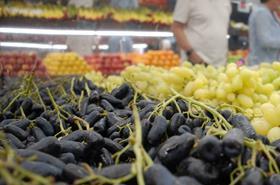
The Southern Hemisphere Association of Fresh Fruit Exporters (Shaffe) has released the results of its first fresh fruit outlook survey undertaken across member countries in the Southern Hemisphere.
The survey found a generally positive outlook for the Southern Hemisphere fruit industry, with e-commerce and consumer health trends identified as major growth areas.
Data collected through the survey indicate China is the second-biggest export destination for Southern Hemisphere fruit producers, after the US.
Shaffe is the trade organisation comprising leading trade associations from across the Southern Hemisphere, including major fruit-producing countries such as Argentina, Australia, Brazil, Chile, New Zealand, Peru, South Africa and Uruguay.
Together, these member countries represent 11m tonnes of annual fresh fruit exports, valued at US$15.7bn as of 2020 — approximately 25 per cent of the global fruit trade.
Dip in volume, spike in value
The total export volume across Shaffe member countries fell by 3.4 per cent from 2019 to 2020, however this did not impact the total export value, which increased by 6.4 per cent from US$14.7m to US$15.7m.
The largest fruit exporters in terms of volume were South Africa at 33 per cent, Chile at 26 per cent, Peru at 12 per cent and New Zealand at 10 per cent, according to Shaffe data.
In terms of export value, the top four were ranked slightly differently, with Chile at 29 per cent, South Africa at 21 per cent, Peru at 20 per cent and New Zealand at 16 per cent.
The two largest importers of Southern Hemisphere fruit in 2020 were the US and China, followed by the Netherlands, the UK and Japan.
Data from the survey revealed the US accounted for 18 per cent of total fruit exports from Shaffe member countries in 2020, with a value of US$2.8bn. China was a close second at 17 per cent with a value of US$2.6bn.
A comparison of Shaffe export figures between 2016 and 2020 reveals rapid growth in the Chinese market share — a 95 per cent increase over four years, compared to a 25 per cent increase for the US, reflecting an increasingly robust demand for imported fruit among Chinese consumers.
The survey also asked members to identify major market access challenges, as well as domestic challenges in their respective countries.
Covid-19 was identified by Shaffe members as the major market access challenge, with related issues such as logistical delays perceived as a key issue.
Meanwhile, 41 per cent of respondents said “domestic protectionism,” which calls for consumers to “eat local”, posed challenges for fruit producers and exporters.
Despite the global setbacks caused by the ongoing pandemic, Southern Hemisphere trade association members maintain a generally positive outlook on the 2021 fruit export season and the future of the industry in general.
When polled about their perception of the 2021 export season, 63 per cent of respondents rated their outlook as “good” and 26 per cent as “fair”.
The impact of the pandemic was reflected in the members’ perception of major short-term growth areas for fresh fruit consumption. E-commerce and health trends were considered the top growth areas, each being cited by 60 per cent of respondents.
Following this were low-cost retail and organics, both at 28 per cent. Sustainability came in at 26 per cent, with the suggestion that it is now seen as more of a basic compliance requirement than a growth area.
In terms of fruit varieties, the top five exports from the Southern Hemisphere between 2016 and 2020 were grapes, kiwifruit, blueberries, apples and cherries. Of these, cherries and blueberries showed the highest export growth, increasing by 110 per cent and 72 per cent, respectively, over the four-year period.
Citrus fruits, while not making the top five exports, were highly represented among member organisations, with 54 per cent of respondents saying their organisation was involved with citrus, followed by table grapes (35 per cent), blueberries (24 per cent), apples (22 per cent), avocados (20 per cent) and pears (17 per cent).






No comments yet